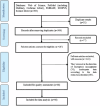Applied distance learning methods in disaster preparedness: A systematic review
- PMID: 38464629
- PMCID: PMC10920769
- DOI: 10.4103/jehp.jehp_1721_22
Applied distance learning methods in disaster preparedness: A systematic review
Abstract
Nowadays, accidents and disasters are one of the most important issues facing humans. Training is an important feature in disasters and distance learning is a suitable method for education in every place and at every time. The aim of this study is to determine distance learning methods in disaster preparedness. This study was conducted to this question: what types of distance learning methods can use in disaster preparedness?". In this study, all published English language papers, with no time limit, were extracted by the end of December 2021 through search in PubMed, Scopus, Google scholar, ISI WOS (Web of Science), and Embase. The primary search used "distance learning", "disaster" and their MeSH terms. Quality appraisal carried out with CASP. Information in the articles including study time, study population, e-learning methods, and type of disasters or emergencies were extracted. Based on the search, 46 studies were carried out between 2002 and 2021. The most studied target group in the studies was health professionals and the content of the courses was attributed to disaster preparedness as well as biological disasters. Regarding e-learning methods, the most used method was 'simulation'. At the time of disasters, including pandemics, disruption in education may be long-term and may require overlapping response and recovery periods. And virtual education during a disaster may be rejected or endorsed by individuals or groups based on cultural, ideological, or prejudicial issues. Distance education can be used for effective disaster education in different phases of the disaster cycle, depending on the available facilities and infrastructure.
Keywords: Disasters; distance education; emergencies; online education; simulation training.
Copyright: © 2024 Journal of Education and Health Promotion.
Conflict of interest statement
There are no conflicts of interest.
Figures
Similar articles
-
Beyond the black stump: rapid reviews of health research issues affecting regional, rural and remote Australia.Med J Aust. 2020 Dec;213 Suppl 11:S3-S32.e1. doi: 10.5694/mja2.50881. Med J Aust. 2020. PMID: 33314144
-
Role of Religious Institutions in Disaster Risk Management: A Systematic Review.Disaster Med Public Health Prep. 2021 Apr;15(2):239-254. doi: 10.1017/dmp.2019.145. Epub 2020 Feb 17. Disaster Med Public Health Prep. 2021. PMID: 32063259 Review.
-
The development of disaster preparedness education for public: a scoping review.BMC Public Health. 2025 Feb 17;25(1):645. doi: 10.1186/s12889-025-21664-0. BMC Public Health. 2025. PMID: 39962440 Free PMC article.
-
Development of disaster nursing education and training programs in the past 20 years (2000-2019): A systematic review.Nurse Educ Today. 2021 Apr;99:104809. doi: 10.1016/j.nedt.2021.104809. Epub 2021 Feb 14. Nurse Educ Today. 2021. PMID: 33611142
-
Disaster preparedness in emergency medical service agencies: A systematic review.J Educ Health Promot. 2021 Jul 30;10:258. doi: 10.4103/jehp.jehp_1280_20. eCollection 2021. J Educ Health Promot. 2021. PMID: 34485555 Free PMC article. Review.
References
-
- CRED Disaster Year in Review 2020 Global Trends and Perspectives [Internet] 2021 [cited 2023 Feb 8]
-
- Najafi Ghezeljeh T, Mohammad Aliha J, Haghani H, Javadi N. Effect of education using the virtual social network on the knowledge and attitude of emergency nurses of disaster preparedness: A quasi-experiment study. Nurse Educ Today. 2019;73:88–93. - PubMed
-
- Monahan C, Ullberg L, Harvey K. 2009 IEEE/INFORMS International Conference on Service Operations, Logistics and Informatics. IEEE; 2009. Virtual emergency preparedness planning using second life; pp. 306–10.
-
- Unver V, Basak T, Tastan S, Kok G, Guvenc G, Demirtas A, et al. Analysis of the effects of high-fidelity simulation on nursing students' perceptions of their preparedness for disasters. Int Emerg Nurs. 2018;38:3–9. - PubMed
-
- Fujioka T. Disaster prevention education in the Japanese school curricula in recent years: Current status and future challenges. In: Shiwaku K, Sakurai A, Shaw R, editors. Disaster Resilience of Education Systems. Disaster Risk Reduction. Tokyo: Springer; 2016. pp. 39–52.
Publication types
LinkOut - more resources
Full Text Sources



